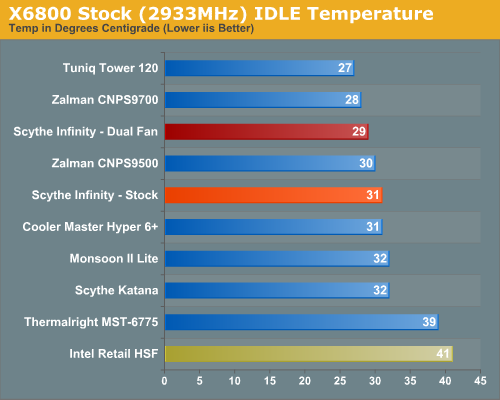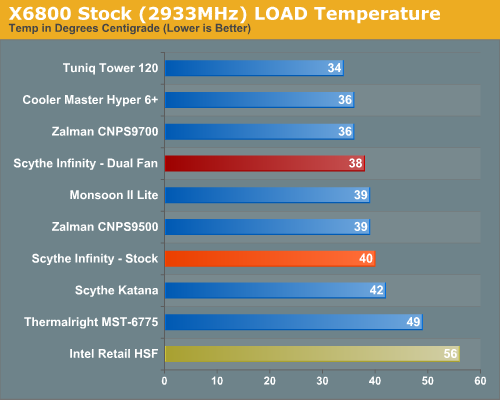Scythe Infinity: 5 Heatpipes and Silent 120mm Fan
by Wesley Fink on February 26, 2007 12:05 AM EST- Posted in
- Cases/Cooling/PSUs
Cooling at Stock Speed
Some users will never overclock their CPU, but they still want to run the coolest CPU temperatures possible to enhance stability and extend CPU life. In this review two new graphs have been added to the test results, so that readers can better compare idle and load performance of the tested coolers at stock X6800 speed of 2.93GHz.

The Scythe Infinity is an excellent performer in CPU cooling at stock speeds. However, when a second cooling fan is added in a push-pull arrangement the cooling gets even better. Stock IDLE cooling is average among the tested coolers with the stock one fan, but a second fan moves the Infinity up as a top performer.
Where the very good Intel stock cooler keeps the X6800 at 41C at idle, the Infinity can manage an excellent 31C/29C, with the stock/dual fans. The push-pull fan setup lands the Infinity in the same ball park with the 27C of the Tuniq Tower and the 28C of the Zalman 9700. These three coolers are the only ones to cool below 30C in our IDLE tests.
It is more difficult to effectively simulate a computer being stressed by all of the conditions it might be exposed to in different operating environments. For most home users CPU power is most taxed with contemporary gaming. Therefore our stress test simulates running a demanding contemporary game.
The Far Cry River demo is looped for 30 minutes and the CPU temperature is captured at 4 second intervals with the NVIDIA monitor "logging" option. The highest temperature during the stress test is then reported. Momentary spikes are ignored, as we report a sustained high-level temp that you would expect to find in this recording configuration.

The stock Infinity was below average under load testing at stock speeds, managing 40C under load compared to the Tuniq 34C and the Cooler Master Hyper 6+ and Zalman 9700 at 36C. Adding the second fan again dropped temperature and improved cooling to 38C for the Infinity dual, which was a better performance.
Some users will never overclock their CPU, but they still want to run the coolest CPU temperatures possible to enhance stability and extend CPU life. In this review two new graphs have been added to the test results, so that readers can better compare idle and load performance of the tested coolers at stock X6800 speed of 2.93GHz.

The Scythe Infinity is an excellent performer in CPU cooling at stock speeds. However, when a second cooling fan is added in a push-pull arrangement the cooling gets even better. Stock IDLE cooling is average among the tested coolers with the stock one fan, but a second fan moves the Infinity up as a top performer.
Where the very good Intel stock cooler keeps the X6800 at 41C at idle, the Infinity can manage an excellent 31C/29C, with the stock/dual fans. The push-pull fan setup lands the Infinity in the same ball park with the 27C of the Tuniq Tower and the 28C of the Zalman 9700. These three coolers are the only ones to cool below 30C in our IDLE tests.
It is more difficult to effectively simulate a computer being stressed by all of the conditions it might be exposed to in different operating environments. For most home users CPU power is most taxed with contemporary gaming. Therefore our stress test simulates running a demanding contemporary game.
The Far Cry River demo is looped for 30 minutes and the CPU temperature is captured at 4 second intervals with the NVIDIA monitor "logging" option. The highest temperature during the stress test is then reported. Momentary spikes are ignored, as we report a sustained high-level temp that you would expect to find in this recording configuration.

The stock Infinity was below average under load testing at stock speeds, managing 40C under load compared to the Tuniq 34C and the Cooler Master Hyper 6+ and Zalman 9700 at 36C. Adding the second fan again dropped temperature and improved cooling to 38C for the Infinity dual, which was a better performance.










39 Comments
View All Comments
SmokeRngs - Wednesday, February 28, 2007 - link
The information you wanted is there. Why are you complaining? There are plenty of people that don't care about the information you want but do want the information you deride. Both are there in a clear and concise manner for those that want to see one or both.
shabby - Monday, February 26, 2007 - link
People who buy $50 heatsinks dont buy them because they're quiet, they buy them so they can overclock their cpu's. Plus they probably stick higher cfm fans, so they're not quiet anymore.Zambien - Monday, February 26, 2007 - link
I disagree. When I bought my Zalman 7700cu for my current PC, the main reason was that it would provide similar cooling to my current HSF, with less noise. I didn't like the fact that my computer sounded like a jet engnine. I'm sure some people fall into the category, but others do not.cujo - Monday, February 26, 2007 - link
why wouldn't you test with overclocks?arswihart - Monday, February 26, 2007 - link
Not to mention they are talking about 50Mhz differences in OC to separate better and lesser performing heatsinks. Come on, that isn't even a significant difference. Did they repeat the result on multiple systems, or just the one. Does it matter? Of course not.arswihart - Monday, February 26, 2007 - link
A heatsink doesn't do anything magic to give you higher OC's, it gives you lower temps, which will then let you OC higher.Measuring a CPU's OC is looking at data that is a step removed from what you should be looking at, which is simply the temperature. I could care less what they get to OC to, it will be almost certainly different for anyone who buys the heatsink.
The only thing that I think is worth taking away from any heatsink review is: installation caveats, temps, and noise.
shabby - Monday, February 26, 2007 - link
I find it funny that the infinity cant beat the tt120, does it have thicker heatpipes or what. What part of the tt120's construction make it better then other beefier/bigger coolers?Superdoopercooper - Monday, February 26, 2007 - link
The first rule in A-B testing is to hold EVERYTHING constant except for the items being examined/tested.Therefore, in ALL of your heatsink reviews, the system down to the THERMAL COMPOUND should remain fixed, even if the heatsink ships with some "higher end" stuff.
I think it would be wise to pick ONE thermal compound and use it on EVERY heatsink test. Then you are testing the performance of the heatsink (i.e. Heatsink #1 is better than Heatsink #2, with no exceptions), and not the thermal grease + heatsink.
I would hate to think that heatsink #1 was the best, but only because it shipped with better compound than another. I think many people ponying up for these higher-$$ heatsinks will pony up $6 for some good thermal grease.
Then, if you want to do an additional test that comments on the performance of the included thermal grease, that would/could be helpful to potential buyers.
Wesley Fink - Monday, February 26, 2007 - link
I can easily link you to a review from a respected source that proves toothpaste and Kraft Vegemite are superior in cooling to Arctic Silver 5 :-) I have tested many thermal compounds and found little differnece among the quality products. That conclusion was a rude awakening for me. I have found much more variation in perfromance in how the thermal grease was applied than I have ever found in the thermal compounds themselves.Thus far, all of the tests have used our standard silver-colored (but no real silver content) tube thermal compound except the Thermalright MST 6775 and the Zalman pair. These came with top thermal grease, and yet none of the three beat our Tuniq or this Infinity. If the cooler company cares enought to supply a premium thermal compound we test with that compound.
Superdoopercooper - Monday, February 26, 2007 - link
If it is true that all thermal compounds are nearly equal, then I guess that's fine. I would like to see the link, actually.That still doesn't change the fact that the best A-B testing holds EVERYTHING constant except the single item being tested.
Since AT is the site I hold in the highest regard in terms of info on computer components, I thought I'd just throw up my $0.02 on ways to maybe make these tests "better" and/or more scientific.
Could just be my test engineering background talking. :-P